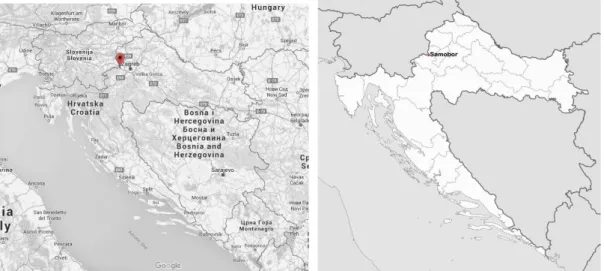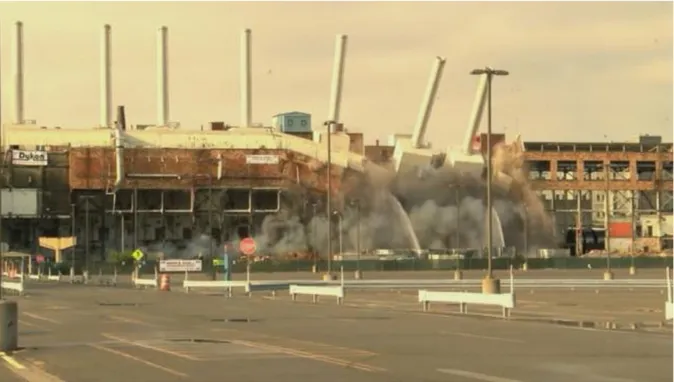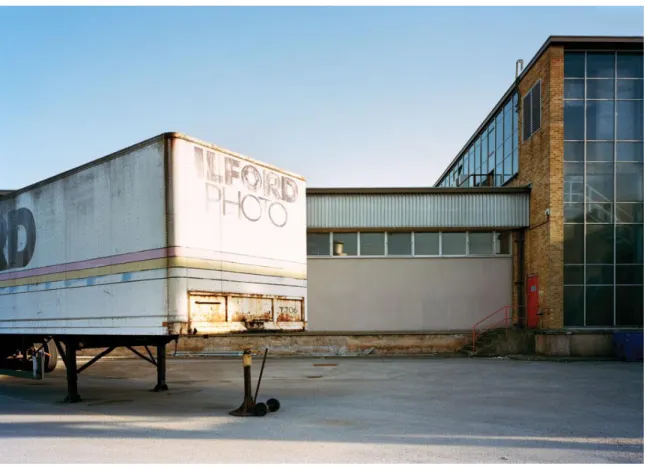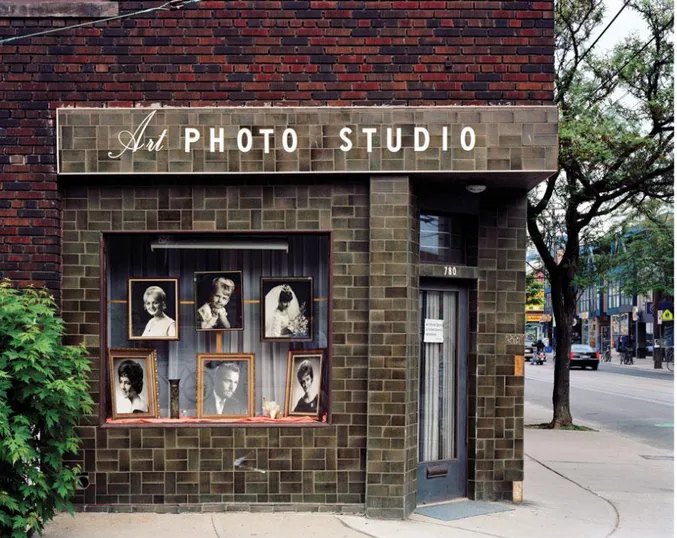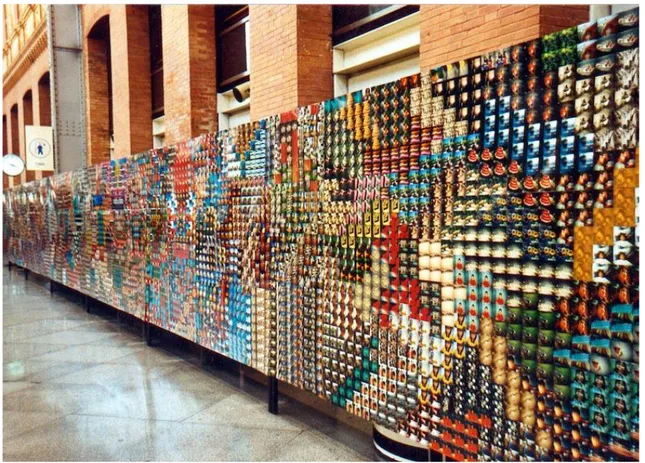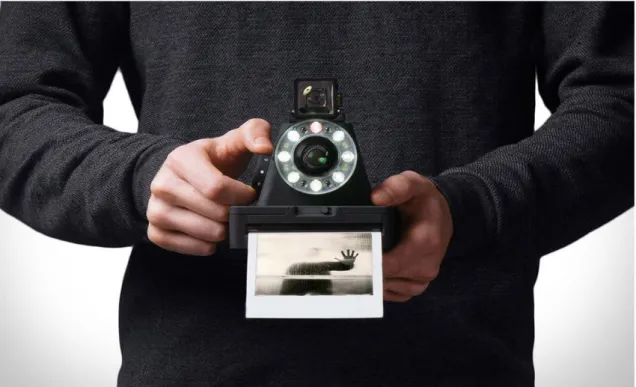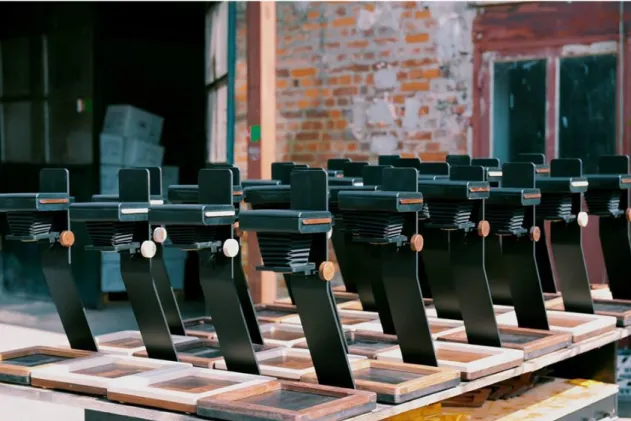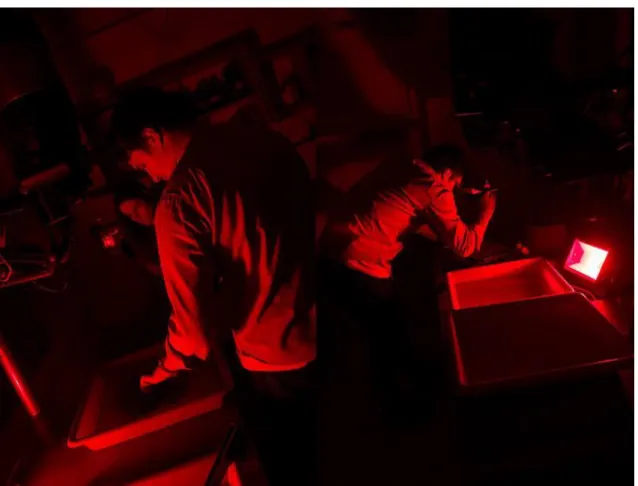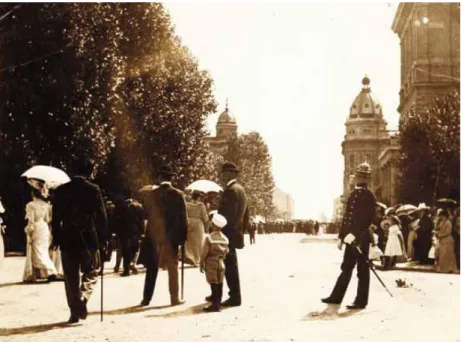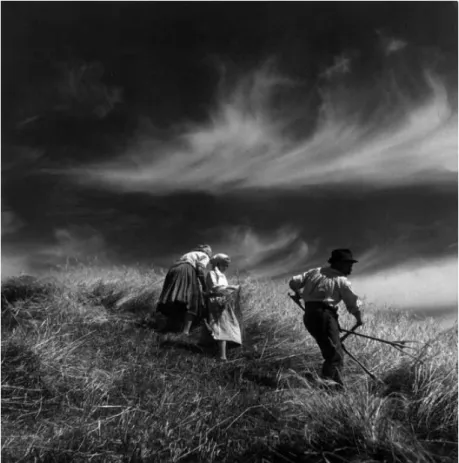1
UNIVERSIDADE DE ÉVORA
Mestrado em Gestão e Valorização do Património Histórico e Cultural -
Master Erasmus Mundus TPTI
(Techniques, Patrimoine, Territoires de l‘Industrie: Histoire, Valorisation,
Didactique)
Former factory Fotokemika as a museum of photography
Nevena Ilić
Sous la direction de: Ana Cardoso de Matos
Évora, agosto de 2016 | Évora, août 2016
3
UNIVERSIDADE DE ÉVORA
Mestrado em Gestão e Valorização do Património Histórico e Cultural -
Master Erasmus Mundus TPTI
(Techniques, Patrimoine, Territoires de l‘Industrie: Histoire, Valorisation,
Didactique)
Former factory Fotokemika as a museum of photography
Nevena Ilić
Sous la direction de: Ana Cardoso de Matos
5
Antiga fábrica Fotokemika como um museu de fotografia
Ao longo do processo de transmissão do suporte fotográfico, do suporte analógico ao suporte digital, fenómeno esse que vê a luz no fim do século XX, a maior parte das fábricas de suportes analógicos vêm os seus dias contados. Como consequência disso, a produção de equipamento fotográfico analógico desaparece e a tradição secular de fotografia analógica está a acabar.
No caso de estudo da fábrica Fotokemika (1947-2012), já famosa e reputada fábrica de produtos fotográficos durante a Yugoslávia, e depois durante a República Croata, o meu objetivo é o de demostrar o que esse processo de transmissão significa ao nível local e global.
Este documento, pelo estudo da fábrica de Fotokemika, como exemplo de unidade industrial fechada que produzia equipamento para processar fotografia analógica, tenta contribuir para um melhor entendimento da posição do processo e da técnica de fotografia analógica no século 21. Este trabalho examina a história da fábrica, os seus resultados nos campos da ciência, tecnologia, técnica, publicidade, design e suas influências ao desenvolver fotografia analógica no território da Croácia criando critérios para a valorização da herança da fotografia analógica.
O objetivo desta pesquiza é o de examinar como é que museus, sendo instituições para a proteção e salvaguarda da herança, sobretudo com a nova definição de museu, podem dar soluções para manter a herança do património industrial num processo de reutilização do edifício antigo num museu.
Palavas-chave: fotografia, fotografia analógica, técnica analógica, herança, herança
7
ACKNOWLEDGEMENTS
With great pleasure I express my thanks to the Master Erasmus Mundus TPTI program that has greatly improved and enriched my professional development, and to all the professors from whom I have learnt a great deal.
I express my deep sense of gratitude to my mentor Ana Cardoso de Matos that guided and encouraged me throughout my research and during the course of writing this thesis. I am very much thankful to my supervisor Guillaume Blanc and professor Massimo Negri for their professional help.
I want to thank you to all secretaries Evelyne Berrebi, Anne-Sophie Rieth, Raffaella Masè and Helena Espadaneira for all help that they provide us in these two years.
I owe great thanks to the curator of Tošo Dabac Archive Zagreb Marina Benaţić for her selfless help and support.
I express my thanks to all the people that I interviewed that were kind enough to share their knowledge and experiences, which has contributed greatly to my research.
I would also like to thank my colleagues Kidane Mariam Woldegiorgis, Anne Pernet, Nevena Tatović, Indira Costa, Dana Salpina, Suzanne Pulcherie Nnomo Ela, Yamaguchi Sawako and Sonia Khaled for their cooperation, the pleasure of working with them and all time that we spent together.
From the heart and with lots of love, I would like to thank my family, mother, father and sister for their unconditional support, motivation and love. Without you, this thesis would never been written.
I would like to thanks to all of my friends who never stopped to belive in me. Special thanks to Tomislav Soldo, Duška Durić, Veronika Gamulin, Ana Vlah, Ţeljka Pleše, Samel Stewart, Miran Barulek, Vanda Volder Stjepić, Ilija Stjepić, Irija Čajavac, Tina Čulo, Iva Stefanovski, Kristijan Radaković, Zdravko Horvat, Virginie Duhamel, Mark
8
Diston, Mia Distonia and Claire Mallet who helped me on many levels trough this wonderful journey.
9
INDEX
Acknowledgements ... 7 Index ... 9 List of figures ... 12 Annex Index ... 14 Resume ... 16 Abstract ... 18 Chapter I – Introduction ... 20 1.1. Research justification ... 201.2. Case study object ... 24
1.3. State of the Art ... 26
1.4. Methodology ... 30
1.5. Dissertation‘s structure ... 32
Chapter II- Museums in a role of saving analog photography ... 34
2.1. New era of museums ... 34
2.2. The disappearing art of analog photography ... 41
2.3. Projects in the new millennium dedicated to the analog technique ... 49
2.4. Role of museums of photography in 21st ... 58
Chapter III- Museums and industrial architecture ... 65
3.1. Industrial heritage in the context of new creative spaces for cultural development ... 65
3.2. Old buildings, new ideas ... 71
Chapter IV- Legacy of Croatian photography and justification for the museum of photography in industrial building ... 78
4.1. The history of photography in Croatia ... 78
4.2. Photography collection in museums and other institutions ... 90
10
4.4. Proposal plan for museum of photography by Petar Dabac in 1986 ... 95
4.5. Neglected industrial architecture and legacy in Croatia ... 97
4.6. Why a museum of photography in Croatia and why in industrial building? ... 100
Chapter V - History and heritage of Fotokemika ... 104
5.1. History and chronology development of Fotokemika ... 104
5.2. Fotokemika - story of one place, story of one time ... 109
5.3. Fotokemika‘s impact on the development of amateur photography in former Yugoslavia ... 117
5.4. Avant-garde design and marketing strategy of Fotokemika ... 121
5.5. The Fotokemika Project - local initiative for saving Fotokemika heritage ... 129
Chapter VI - Proposal plan for Fotokemika-museum of photography ... 132
6.1. Fotokemika today - analysis of the situation ... 132
6.2. Valorization of Fotokemika heritage ... 135
6.3. The concept of the Fotokemika-museum of photography ... 138
6.4. Fotokemika-museum of photography and cultural development of the city of Samobor ... 142 Conclusion ... 146 Bibliographic references ... 151 Archive Sources ... 156 Internet sources ... 158 Interviews ... 161 Annexs ... 162
12
LIST OF FIGURES
Figure 1 Map of Croatia and city of Samobor on map of Croatia……...24
Figure 2 Demolishing 92-year-old Kodak Building in Rochester………... 43
Figure 3 Ilford paper closed building... 45
Figure 4 The Art Photo Studio in Toronto... 46
Figure 5 LomoWall of 120 meters in Madrid... 50
Figure 6 New instant camera I-1 made by Impossible Project…... 53
Figure 7 Enfojer - enlarger for developing photos from smart phones and film... 55
Figure 8 Enlarging negatives and developing photos of Tošo Dabac... 57
Figure 9 Vladimir Guteša, Zrinjevac on Corpus Christi... 81
Figure 10 August Frajtić, Our Daily Bread………... 82
Figure 11 Tošo Dabac, Mercedes Goritz Pavelić i Ljubica Valentaković…... 83
Figure 12 Ivana Meller – Tomljenović, Dictatorship in Yugoslavia………... 84
Figure 13 Malden Grčević, From the bird's eye view... 85
Figure 14 Milan Pavić, Crossroads………... 86
Figure 15 Slavka Pavić, Kompozicija... 87
Figure 16 Magazine SPOT, cover of first edition... 88
Figure 17 Tošo Dabac, Petar Dabac, Marija Braut and Enes Midžić... 89
Figure 18 New building in Samobor and works council... 108
Figure 19 Research laboratory in Fotokemika ... 112
Figure 20 Covers of Fotokemika magazines... 116
Figure 21 Efkić on Zagreb main square... 121
Figure 22 Fotokemika logo... 122
Figure 23 Advertisement campaigns done by Josip Sudar and Dušan Bekar... 124
Figure 24 Fotokemika game done by Josip Sudar and Velimr Vrbos... 124
Figure 25 Dušan Bekar design for commercial poster………... 125
Figure 26 Aleksandar Srnec graphic design for Fotokemika... 127
Figure 27 Fotokemika machines for production of films... 134
14
ANNEX INDEX
1. Map of Croatia, map and images of city of Samobor……….. 163
2. Chronology of Fotokemika factory ... 164
3. Fotokemika logo done by Jospi Sudar and Dušan Bekar………. 168
4. Commercial advertisement from Fotokemika magazine 1954-1955………... 169
5. Commercial posters done by Josip Sudar and Dušan Bekar, 1950-1960……….... 185
6. Commercial posters for Fotokemika factory, Aleksandar Srnec, 1961……..……. 189
7. Fotokemika enlarger design by Đuro Griesbach, 1950……… 190
8. Images of Fotokemika factory 2016……….………...………. 191
9. National museum for photography, concept by Petar Dabac, 1986 ... 192
10. Tošo Dabac 1907-1970, biography and photos ………. 195
11. Nevena Ilić photography done with analog camera and film in 2014-2016 during TPTI ………. 201
16
RÉSUMÉ
Au cours du procédé de transmission du médium photographique, du support argentique au support numérique, un phénomène voit le jour à la fin du 20ème siècle: la plupart des fabricants de supports argentiques au fur et à mesure ferment leurs portes. En conséquence, la production de matériel photographique s‘arrête et cette tradition séculaire de la photographie argentique doit faire face à l‘abandon et à la disparition progressive.
Dans l'étude de cas du fabricant Fotokemika (1947-2012), une ancienne fabrique de matériel photographique en Yougoslavie et plus tard de la République croate, mon objectif est de démontrer ce que ce processus de transmission signifie au niveau local ainsi qu‘à l‘échelle mondiale.
Ce document, à travers l'étude du cas de Fotokemika, en tant qu‘exemple d'unité industrielle fermée qui fabrique du matériel pour la photographie argentique, tente de contribuer à une meilleure compréhension de la situation du processus et de la technique de la photographie argentique au 21ème siècle.
L‘étude explore l'histoire de la fabrique, ses réalisations dans les domaines de la science, de la technologie, la technique, la publicité, le design et son influence sur le développement de la photographie argentique sur le territoire de la Croatie en créant des critères pour la valorisation du patrimoine de la photographie argentique.
L'objectif de la recherche est d'examiner comment les musées, en tant qu‘institutions responsables pour la protection et la sauvegarde du patrimoine, surtout après leur nouvelle définition, pourraient encourager la conservation du patrimoine industriel dans un processus de réaménagement d‘un ancien bâtiment industriel en musée.
Mots clés: la photographie, la photographie argentique, technique de la photographie
argentique, le patrimoine, le patrimoine immatériel, patrimoine industriel, réhabilitations et reconversions des sites industriels, musées, mémoires.
18
ABSTRACT
In the transmission process of a photography medium, from analog to digital, a phenomenon that occurs at the end of the 20th century, most of the analog photo factories are being shut down. As a result, production of photo equipment dies and centuries-old tradition of analogue photography is disappearing into history.
In the case study of Fotokemika factory (1947-2012), once a famous and respectable photo equipment factory during Yugoslavia, later the Croatian Republic, I am showing what this transmission process means on a local and global level.
This paper, trough case study of Fotokemika factory, as an example of shut down industrial unite that produced equipment for processing analog photography, is trying to contribute to a better understanding of position of analog photography process and technique in 21st century. The study examines the history of the factory, the achievements in the fields of science, technology, technique, advertisement, design and its influence on developing of analog photography in the territory of Croatia creating criteria for valorization of analog photography heritage.
The research aim is to examine how museums like an institution for protection and safeguarding of heritage, especially after the new definition, can give a solution in maintaining industrial heritage in a process of reusing former industrial buildings into museum.
Key words: photography, analog photography, analog technique, heritage, intangible
20
CHAPTER I - INTRODUCTION
Le premier chapitre présente les orientations de la recherche : l'étude de cas de l'emplacement historique et géographique Fotokemika, une enquête scientifique, et la méthodologie de recherche que je vais utiliser pour ce travail. De plus, je vais présenter une vue d'ensemble de l'état de l'art sur le sujet des musées, du patrimoine industriel et de la photographie.
This thesis is broadly focused on the themes of heritage, memories and photography. Within these broad themes, areas such as industrial heritage, industrial reutilization and museums will be discussed.
The goal of this thesis is to make a conceptual proposal for the reutilization of a disused factory building into a museum. My case study is the former factory Fotokemika, in Samobor, Croatia- once a very important industrial unit that produced equipment for processing analog photography, such as films, papers and chemicals.
The first chapter will explain the justification for the research, including a case study which will cover Fotokemika‘s historical and geographic location, scientific inquiry, and the research methodology that I will be using in this work. Furthermore, I will provide a general overview of the existing literature on the topic of museums, industrial heritage and photography.
1.1. Research justification
A museum is a non-profit, permanent institution in the service of society and its development, open to the public, which acquires, conserves, researches, communicates and exhibits the tangible and intangible heritage of humanity and its environment for the purposes of education, study and enjoyment.1
After years of discussion in professional circles, ICOM adopted this definition on the 22nd General Assembly in Vienna, Austria on August 24th, 2007. In essence, that definition expanded the role of museums, with the emphasis not just being about
21
collecting objects any more, but on communication and exhibit values of the tangible and intangible heritage. In the 21st century a lot of museums started to build their mission and move their philosophy in that direction. Museums dedicated to art are still lagging behind in presenting their work in this way, and their duty is still primarily to preserve and present their collections, in the form of physical objects. Museums specializing in the field of photography are also included in that category. In overview, photography museums are divided into two categories. First, museums dedicated to historical objects, such as cameras and equipment showing the development of media through history. The other category of photography museums are those with collections of printed/developed photos of artists known in the photographic world promoting historical, modern or contemporary photography, through exhibitions. Despite, these two kinds of museums, there is something that connects them; they create their collections based on artifacts or authentic objects and the philosophy of presenting these objects to the public, with no interaction with visitors.
First of all, let's define an object in a museum. A museum object is something which musealised, an object that is removed from reality into the museum context. Depending on the changing of museological theory, or the development of new spheres in museology throughout the history, this definition has changed a lot. For example from the point of view of a structuralist approach, the museum object is a document, sign or part of heritage, philosophic approach is talking about that museum object is not same like a thing, a new museology school is putting away the term of a museum object and talking instead about the heritage. The approach of the new museology school is starting to become the most prominent one internationally in the museum world. In art museums, the collections are mostly created in the form of physical objects, and they created unconsciously thinking that the museum object is only physical things. The idea of authenticity is particularly important in fine arts museums (masterpieces, copies and fakes) and influences the majority of the questions attached to the status and value of museum objects.2
2 Available at:
http://icom.museum/fileadmin/user_upload/pdf/Key_Concepts_of_Museology/Museologie_Anglais_BD. pdf. (Accessed 1 May 2016)
22
Authentic objects in museums of photography are very rooted in their environment and they present the core values of art museums of museums. The question of what an object in museums of photography really is, started to be questioned during the big transformation of media. The metamorphosis from analog to digital started to revitalize museums of photography to think more of their intangible heritage. One of the best examples is the frequent discussions about the topic of photography in social media, as a part of everyday life, and its continued move in that direction.
At same point, with the development of new technology and modern media, analog technology and techniques started to be seen in a secondary role, slowly disappearing from everyday lives. Already, at this point in time, a younger generation is often curious about analog photography, often not understanding exactly what it really means.
With the invention of digital photography, the analog process started to slowly vanish from the global scene, especially after the millennium, when improvement of digital technology became completely mainstream. At the same time as the rapid process of digitalization, came the rapid collapse of the analog photo industry. Just in the last ten years almost all factories of analog film closed their doors, leaving the entire tangible and intangible heritage behind.
Museum professionals are more concerned about how they will be able to manage with the change of medium, and how they will present 'objects' now. In only a few museums is there an awareness of the analog legacy, shown occasionally through workshops. The processes of analog photography stayed dominant only in departments of photography, in art schools. At this point, transit on a global level from analog to digital in photography passed almost invisibly. Thanks to the social network Instagram and popularity of digital photography processed by filters to look like an old photo, the curiosity for analog film is starting to make a comeback. With the closure across the world of factories dedicated to the photo industry, material and chemicals for analog photography had been harder and harder to find, but, thanks to this new social media interest and new demand in the market, factories like British Ilford and Japanese Fuji survived. The question is, is it just a trend, or enough to make the analog process live again?
23
If we consider the definition of museums again, it‘s a perfect time for museums of photography to participate in taking care of the analog process, which should be recognized as a heritage, and rejuvenated again, and stop it being just an exhibit in the 'cabinet of curiosities' of photography.
The aim of this project is to create a proposal for the former factory of photo material Fotokemika in Samobor, Croatia, as a museum of photography, where its technical, social and artistic - aesthetic heritage could be evaluated, conserved and treasured. The final goal is to make a museum in which an analog process could be brought to life again, to create a center which will promote photography in every aspect, giving space to a younger generation of photographers to create a core which will combine tradition and future visions of the role of museum of photography.
Research is also directed into finding an answer to the question as to why a museum of photography does not yet exist in Croatia, considering its long and rich photography tradition and many different photographic collections in other museums and institutions. The final problem this project deals with is trying to answer the question of what is going to happen to the closed Fotokemika factory and also proposing tools for it‘s protection, in a form of conversion, so it doesn‘t become just another neglected object of industrial heritage of Croatia.
Research is directed towards giving the best possible solution to transforming former industrial buildings into museums. The best possible concept is to use this gem of industrial heritage to create a Museum of Photography, a unique place where past, present and future meet- providing a whole new experience of photography.
24
1.2. Case study object
The city of Samobor in Croatia is known as a small historic town within the Zagreb metropolitan area. Since 1242, according to a document of endowment by King Béla IV, it has held the status of a free royal town. Today it is a part of the Republic of Croatia and a popular tourist destination.
Fig. 1. Map of Croatia and city of Samobor on map of Croatia
Source: www.karta-hrvatske.com.hr
As well as Samobor‘s history, it is also known for its industry. One of the chief industries in Samobor is crystal cutting, acclaimed in Europe and all over the world. But a few years ago, the city was known by one of the few factories in the world that still produced all the necessary materials for the analog process of making photographs, Fotokemika.
The birth of the photo industry in former Yugoslavia started after the Second World War in the time of major renovation. With the demands of the market, and on the initiative of a group of photographers and photographic experts the idea of photo factory was born. By merging companies Photo and Ozacel they formed a stock company
Fotokemika which began building a factory in Zagreb in 1946. They started with the
production of black and white photo paper, photo chemicals, and simple cameras. Soon after, in 1952 the new plant in Samobor was opened where they produced among other products, photographic, cinematographic and x-ray film. At that point the only
25
countries that had a photo industry were Germany, Belgium, England, France, Italy, the former Union of Soviet Socialist Republics, USA and Japan. Fotokemika was once one of the region‘s most successful photochemical companies.
What started as a small regional company, Fotokemika became a big player in the photo industry with the creation of brand eFKe, which included films and materials for analog photographic processes. Because of improving the products inside of Fotokemika was established laboratory for chemical testing of products with the leading names from chemistry industry.
The formulas for black and white film production were bought from company Dr.
Schleussner GmbH of Frankfurt aus Main, in the photographic world this is better
known as ADOX, the world‘s first photographic materials manufacturer, which developed their legendary silver rich black and white films.
Silver in films produced quality of printed image, and made eFKe brand one of the best known films in the world, especial edition KB25 films. Because of a lack of money, and competition from large conglomerates like Kodak, Fotokemika stopped pursuing improving their technology for films in color in the 1980s and instead continued with black and white production, which made it the last factory in the world that produced films with silver, until eventual closure in 2012. Even today many professionals believe that theirs was the best film in the world.
It is important to highlight that a key part of the photo manufacturing industry is the actual machinery. Each factory had bespoke machines constructed by the engineers. The machines, on which the eFKe films were made, were until recently, the last original machines designed to create the special film and originated from the ‘50s and ‘60s. They were partly bought and partly invented and built by their own engineers. Most of the knowledge, like chemical processing and building of machines, is known only by the former employees of Fotokemika. Many of them were trained at the factory while still studying and had been working there ever since. They are the true specialists that hold the knowledge and well-kept secrets of eFKe‘s traditional film making.3
26
Amongst the Fotokemika factory experts, were some of the leading chemists and engineers in the country, responsible for improving the product in field of photo industry. Managers employed Josip Sudar, who is considered a pioneer of marketing in the former Yugoslavia. Thanks to Sudar marketing campaigns, Fotokemika accessed different world markets very soon after it opened. Sudar‘s vision was accompanied by an avant-garde tendency of visual expression at the time. He started collaborating with Aleksandar Srnec, one of the most famous Croatian artists, whose signature works feature geometric abstraction and a minimalist aesthetic. Second half, beside Sudar, in creating public image eFKe brand was Dušan Bekar, chief designer at Fotokemika in the 1950-60s. Using today's terminology he was the equivalent of the company Art Director. During those years, with both the vision of Sudar and the modern, contemporary design of Bekar, Fotokemika achieved a record-breaking success, and from this point of view, it could be said that was the 'golden age' period for Fotokemika.
The case study for this project will be the Fotokemika factory, with all tangible and intangible heritage, that was created during the 65 years of its existence. Its effect on the global scene of the analog photo industry has to be emphasized, creating an increasing regional and local influence on the development of photography in the former Yugoslavia, especially in the territory of Croatia.
1.3. State of Art
Fotokemika factory published a factory magazine called Fotokemika, magazine of
working collective enterprises, ‘Fotokemika‘ factory of films and photo paper from the
year 1954 until 1994. Editorial section made of articles dedicated to work of factory, to scientific research in field of photography, improvements in technology of analog photography and reviews from exhibition of photography give an overview of Fotokemika work of 40 years. The magazine is important because it is only place with information where can be readably all the aspects of factory from business, propaganda, science until the social component. The Fotokemika factory until the present day has
27
not been the subject of scientific research, so there is a lack of written literature in that direction. Only a small amount has been written about Fotokemika, in the catalogues of two exhibitions. The first exhibition was held at the Museum of Art and Crafts, 1966, titled 100 years of photography in Croatia (1840-1940): 20 years Fotokemika. The exhibition presents an overview of the graphic design of Fotokemika factory, from posters to product design. Radoslav Putar, author of the text, and a leading art historian of the time, on visual analysis of works speaks about advanced design within the company in the context of that time. Other exhibition is organized by Gallery of City
Zagreb forerunner of the Museum of Contemporary Art, with the title Croatia photography of the nineteen fifties to the present. Development Fotokemika from 1947 until today, held in 1993. In the context of Fotokemika factory, this catalog is important,
because for the first time, official chronology of factory was published. Another thing which is important to emphasize is text in introduction part, where is written that exists of Fotokemika factory, like the only photo-industry in this region, created prerequisites for the development of the photographic medium.
Despite this two catalogs, like an only written publication, with little bit of thematic of Fotokemika, research will be concerned more on archive work, and literature that is connected with its legacy, such as describing the work of Aleksander Srnec in its context.
About the work of Aleksandar Srnec in Croatia art history was written a lot, especial in the context of EXAT 51, the group of artist which artistic expression was marked with the geometric abstraction in the begging of 1950s. Srnec work always had pretensions to be looked in artistic environment and about his work as a graphic designer didn‘t been written a lot until the exhibition Aleksandar Srnec, Present Absence held in
Museum of Contemporary Art in 2008. Presenting his entire opus, for the first time his
work in context of graphic design got properly spaces in exhibition with text written by
Feđa Vukić, theorist of the history of design in Croatia. Vukić is speaking in text about
all the graphic design that Srnec had done, but gives a title just dedicated to Srnec works for industrial companies, including work for Fotokemika too.
28
At present, the process of transition from analog to digital photography continues. Simply by looking at the statistics for closed factories in the analog industry, it could be said that the predominance of digitalization in photography now is very high. Considering that we are still in that process, there is a lack of literature dealing with the issue. A project of the photo documentation of vanishing and closing factories of the photographic industry that photographer Robert Burley started in 2005, led to the production of a book with the title The Disappearance of Darkness: Photography at the
End of the Analog Era, in 2012. This book contains his photographs and the theoretical
essays of curators, including essays on the topic of the state of analog photography in a digital age. This is one of few sources edition that deal with this subject matter.
In the beginning of 20th century photograph activities in Zagreb were very strong and in 1930s was active movement called ‗Zagreb School of Photography‘. Despite the fact of importance of that period, in the literature didn't exist in a book form until the big exhibition in Zagreb in Museum of Arts and Crafts in 1994, Photography in Croatia
1848-1951, under the supervision of curator Marija Tonković. The catalog of the
exhibition presents the overview of development of photography and presents the most significant names of that period. The exhibition and the catalog were the product of many years research that Marija Tonković dedicated to photography as an expert and the head of department for photography at the Museum of Arts and Crafts in Zagreb.
Second part of the twentieth century about history of photography in Croatia was structural concise in a work of Želimir Koščević, a leading theorist in contemporary art and photography in Croatia. He was one of the key figures of the contemporary art scene and one passionate driver of many events related to photography in Croatia. After many years work, he wrote a book in 2002 called Photography picture - 160 years of
photographic art in which he deals with the subject of Croatian photography in the
context of the world with artistic and theoretical aspects. The book is divided into six chapters, in chronological order, from after the first photos in 1839 and the events that immediately preceded it, to the ending where the final essay describes the challenges at the end of the millennium. It should be emphasized that is the first book in which there is a systematic overview of Croatian photography after the 1950s. Beside this book,
29
Želimir Koščević in the book History of European Photography, 1900-1938, was an
author of essay The History of Croatian Photography in period of 1900-1938.
In addition to books of Croatian photography it should be mentioned that periodic works have been issued by Centar za fotografiju, film i televiziju (Center for
Photography, Film and Television), CEFFT, in which the photography had plenty of
space. One of the most important issues published by CEFFT was magazine SPOT, going out in period of 1972-1978, dedicated to contemporary photography on that time. In contemporary time‘s editions of the journal Život umjetnosti (Life of Art), where are a lot of theoretical articles about the position of photography today.
Awareness of industrial heritage and the recognition of its value in the former Yugoslavia started in the 1980s and the first writing about Zagreb‘s industrial past was in the magazine: Informatica museologica with the title Museological challenge of
industrial archeology in 1982, written by Višnja Zgaga. Because of the civil war and
the unstable situation in the 1990s, all aspects of culture suffered. But at the beginning of new millennium, the city of Karlovac hosted the first Croatian symposium on the
transformation of industrial heritage in new urban landscape scenery, organized by the Society of architects, builders and surveyors from Karlovac. On that occasion,
appeared: City for the 21st century, today one of the most important collections of written texts about industrial heritage in Croatia.
The next publication which presented new tendencies and examples of industrial heritage was an edition of the magazine Informatica Museologica, which in Vol.38 in 2008 was dedicated to all forms of the presentation of new achievements in industrial heritage topics.
Thanks to the existence of TICCIH (The International Committee for the Conservation
of the Industrial Heritage), international society dedicated to promotion and protection
of industrial heritage on all level, today we have many published edition on this subject. The crucial issue is Industrial Heritage retooled: the TICCIH guide to industrial
heritage published 2012, which brings together a series of works on the theme of
30
deal with the topics of valuation, protection, transformation, and the adoption of new theoretical concepts of industrial heritage. This collection gives an insight into the big picture of today's situation in a field of industrial heritage, pointing to examples of how theory works in practice.
On the other hand, in the field of museums and its theories, the leading work is A
Companion to Museum Studies, published in 2006, which captures the multidisciplinary
approach to the study of the development, roles, and significance of museums in contemporary society. In this collection of essays a new era of museums is presented, postulating what museums of the 21st century should be like and what is their responsibility to society.
Eileen Hooper-Greenhill, professor Emeritus on University of Leicester, is a, perhaps the, leading practitioner in field of museum studies and the concepts concerning them. She is the one of the experts that introduced postmodern theory into a museum field, creating the concept of post-museum. In her first book, Museums and the Shaping of
Knowledge, published in 1992, she announced post-museum as the future,
museum-to-come, which concept she will explain in the next book Museums and the Interpretation
of Visual Culture, from 2000. Trough the book, the author examines the relation
between object and audience, and asking the question is still collection will be essence of museum in future.
1.4. Methodology
In the case study of Fotokemika factory, I will base my research on the analysis of archival material, which will enable me to construct the historical overview of the company. Fotokemika case never has been a subject of scientific research and despite that fact there are a small number of written texts on thematic of Fotokemika in other publication. Considering that fact with archive materials I will be able to construct historical frame of Fotokemika factory with information which will give new approach for understand its roll in history and determine its importance as heritage.
31
Beside work in archive, my research will include a field work, which will help me to understand today situation of factory and construct models for valorization of its heritage. Fieldwork allows a deeper insight into pre-inventory of the machinery, materials and photographs that existed in the factory to have one idea of its importance. Research also includes people such as engineers, photographs and artist linked to the Fotokemika to stress the significance of their work in the context of the factory.
Theoretical research will deal with the subjects of museums and industrial heritage. In museum field it is important to explore development of museums and there position and role in 21st century, especially after the new definition. How the subject of research include industrial heritage monument, the work will be study principles on industrial heritage with historical overview, and analyze existents examples of reutilization for better understanding Fotokemika possibilities in that direction.
Furthermore, using a qualitative approach to better understand the social significance of Fotokemika factory, I will conduct semi-structured interviews with members of the Fotokemika community, namely former workers, users of Fotokemika products, professional and amateur photographers and the citizens of the city of Samobor.
This research is based on constructivist paradigm. Constructivist grounded theory acknowledges the subjectivist stance of researchers who ‗construct our grounded theories through our past and present involvements and interactions with people, perspectives and the research practices‘.4 Constructivist grounded theory is based on the data - inductive approach, continuous coding material and return to reading materials in the light of new themes and codes.
Creating a group Fotokemika community, I‘m trying to study protagonists in their historical and social context of trying to understand and interpret the meaning or significance of their actions and experiences connected with field of photography.
4 Charmaz, K., Constructing grounded theory: A practical guide through qualitative analysis. Thousand Oaks, CA: Sage, 2006, p.10
32
Multiple perspectives of those involved in the case of Fotokemika factory aiming to gather collectively agreed upon and diverse notions of what occurred.
To gain a holistic perspective, diverse members of the community will be interviewed. From Fotokemika community will be taken two protagonist of the group which is divided in categories of workers, users and citizens with question relevant in relationship of them and Fotokemika. Each group will containe equal number of genders, women and men. In the group of workers average age is between 60-70, in users 30-90 and in citizens 30-40.
The form of interview with different groups on same subjects is giving different view of the same things, and differently constructed meanings of Fotokemika factory and analog photography. With this approach is trying to get global picture of Fotokemika influence on different levels and open the field for furthermore research.
1.5. Dissertation’s structure
This dissertation is structured in 7 chapters, which presents the project from its justification until the conclusion.
In the first chapter, the goal of project is presented, why this research is needed, where are the gaps in knowledge in the field of museums of photography, and in the field of industrial heritage in Croatia. Also a general overview of the existing literature is presented about the major topics in my thesis and the best methodology to be used.
Chapter two introduces the problem of the situation of analog photography in the digital age and attempts to give a solution to the new vision of the role of museums in the 21st century. In this chapter the main topics of this thesis are reviewed; the disappearance of analog photography techniques and how the new vision of museums can help in the process of transmission of media.
The third chapter is dedicated to terms of industrial heritage, adaptive reuse and museums. The aim of this chapter is to show historical overview of developing the field
33
of industrial heritage and what it‘s perception in 21st century. Also the aim of chapter is to show the examples of converting industrial architecture into a museum and adaptive reuse, considering the criteria for proposed plans for Fotokemika as a museum of photography, with the goal to show how it can help in cultural development of the city. Considering the long tradition and history of photography in Croatia, even today there is a big question in professional circles, why there is not a specialized institution for photography, in a form of museum or center.
The fourth chapter presents an answer to this question, emphasizing why the future museum should be in an industrial building, also rising problematic of protection of industrial heritage in Croatia.
In fifth chapter will give a history of the Fotokemika factory with its entire tangible and intangible heritage. The aim is to present the factory in the context of the region and to see its influence on the development of photography in the territory of Croatia.
In the sixth chapter is a proposed plan for Fotokemika-museum of photography, from the description of today's state, criteria of valorization of its heritage to a museological concept of the Fotokemika-museum of photography. Also, the aim is to show how reutilization of industrial building can help in a cultural development of the city based on examples presented in chapter three.
Finally, at the end is conclusion based on research done with analysis of data and proposed plans for a museum of photography.
34
CHAPTER II - MUSEUMS IN A ROLE OF SAVING ANALOG
PHOTOGRAPHY
Le chapitre deux introduit la problématique de la place de la photographie argentique dans l'âge numérique et tente d'esquisser une nouvelle vision du rôle des musées pour le XXIème siècle. Dans ce chapitre, les principaux sujets du mémoire sont examinés: la disparition des techniques de l'argentique et comment ces nouveaux musées peuvent être utiles dans le processus de transmission des médias.
2.1. New era of museums
ICOM has for some time been formally reconsidering the definition of the museum, as contained in its Statutes. Quite recently the question has been raised: Why does ICOM need a new definition of the museum?5
This is the first sentence of an article From Specialist Reference to Social Recognition
and Service of ICOM News Magazine on topic The Definition of the Museum, in 2004,
which was written by the Bernice L. Murphy, at that time Vice-President of ICOM. At the beginning of the 21st century museums have been in the process of metamorphosis, conditioned with the big changes in society influenced by growing globalization which culminates at the beginning of new millennium. Precisely for this reason, in the sphere of the cultural world, there is one of the biggest turning points in terms of the notion of heritage. At a General Conference of UNESCO, in Paris in 2003, a Convention for the
Safeguarding of the Intangible Cultural Heritage was adopted. It said: 'Cultural heritage does not end at monuments and collections of objects. It also includes traditions or living expressions inherited from our ancestors and passed on to our descendants, such as oral traditions, performing arts, social practices, rituals, festive events, knowledge and practices concerning nature and the universe or the knowledge and skills to produce traditional crafts.' 6
5 Available at: http://icom.museum/fileadmin/user_upload/pdf/ICOM_News/2004-2/ENG/p3_2004-2.pdf (Accessed 10 May 2016)
6 Available at: http://www.unesco.org/culture/ich/en/what-is-intangible-heritage-00003 (Acessed10 May 2016)
35
This new approach to heritage defines a better way of expanding the field and value of heritage, museums started to review the definition which was adopted in 1974. By that definition, a museum is a non-profit making, permanent institution at the service of society and its development, and open to the public, which acquires, conserves, researches, communicates, and exhibits, for purposes of study, education and enjoyment, material evidence of man and his environment.7
In this definition the word material should be underlined, it describes most of the missions of museums who build their collections on physical objects. Parallel with the raising the awareness of importance of non-material heritage in the 21st century, discussion in museum fields started, with the prime question being: is this definition enough to cover all tasks that a museum is supposed to cover in its role to serve society. The importance of intangible cultural heritage is not the cultural manifestation itself but rather the wealth of knowledge and skills that is transmitted through it from one generation to the next.8 This is the key sentence in which experts of UNESCO describe what is intangible heritage and asks professionals in the museum world, in a global era to start to think more about values of non-material aspects of culture and how they could be implemented in the museum environment.
If we look at the historical overview of the development of museums, we can see the occurrence of the movement called eco museums which started in central France in 1971. This was one of the first movements of museology into a new direction, moving the boundaries of traditional points of view about the meaning of museum objects and their connection with the community.
The eco museums story begins after World War II, when in the region around the towns of Le Creusot and Montceau-les-Mines almost 150,000 locals lost their jobs because of the shutdown of one of the biggest industrial plants in that part of France. A unique solution for the recovery of the region and its economic development was proposed by
Hugues de Varine, Georges Henri Rivière and Marcel Evrard, who proposed The Museum of Man and Industry, a museum that was to startup the economy again, but
7 Available at: http://archives.icom.museum/hist_def_eng.html (Accessed 10 May 2016)
8 Available at: http://www.unesco.org/culture/ich/en/what-is-intangible-heritage-00003 (Accessed 10 May 2016)
36
also, perhaps even more importantly, help the local population rediscover meaning, their own identity, and open new development possibilities.9
The revolutionary approach in this case lies in the emphasis of all heritage connected with the project. In center of museum was the Schneider family‘s castle, the defunct industry‘s ex-owner‘s house, in which was presented collections of the objects in relationship with the past, but the philosophy of the museum was to cover all parts of the region that was somehow connected with the everyday life of habitants and creating
in situ places with tangible and/or intangible testimonies of community. In the year
1974, when it was completed, it became known in the museum world most of all due to its collection definition published in the Museum magazine: 'Any movable or
unmovable object within the community‘s perimeter is a notional part of the museum. This introduces the idea of a kind of cultural ownership, which has nothing to do with legal ownership'.10
After this example, which was a breakthrough new concept of museums and museology, the first countries that followed this concept was French-speaking part of Canada and later Scandinavia peninsula, and then in other countries, started to appear many kinds of this type of museums.
Since that period the museum world has undergone radical change. The circumstances in which they found themselves, affected by economic and political factors, forced its professionals to shift their attention away from their collections towards visitors. Model eco-museums served as a bridge in the transition and conditioned the various variants of the museum that are in its mission, which is more turning towards visitors and interaction with them.
For the past thirty years the Museum of Man and Industry in France has raised question in ICOM magazine, and in that time many kind of museums developed, which are not basing their mission on collection and objects or doing so only partially. If we compare, a traditional museum, which is based on the principle of object philosophy, and display
9 Babic D, Experiences and (hidden) values of ecomuseums. Ethnological Researches 1 (14), 2009, pp. 237-252.
37
character, to the opposite examples such as a science center and children‘s museums which provide programs to stimulate informal learning experiences with a philosophy of touching objects, creating a full experience of interactivity. From these two extremes, eco museums on one side and traditional museums on another side, were created other versions of the museum that cannot be placed in either one of them. Examples are one-object museums, such as a ship museum or a house museum with a plethora of culturally associated objects, the avocation lists‘ museum that puts its member‘s models on exhibition but does not concern itself with acquisition, preservation or research, the art museum that appears not to have acquired a permanent collection.11 The definition of museums from 1974 excludes these kinds of institutions because they are not based just on material heritage, but also as a service for society and its development. In the issue of ICOM magazine from 2004 Paul F. Donahue, Executive Director of Museum Services
Canada Science and Technology Museum Corporation, in his article
Collection=Museum?12 asked the question: 'Do we principally exist to collect or to
inform?'13 considering the fact through all the changes the museums passed in three decades, questioning which of their functions is more important.
Finally on the 22nd General Assembly in Vienna, Austria on August 24th, 2007, ICOM adopted a new definition of which it states: 'A museum is a non-profit, permanent
institution in the service of society and its development, open to the public, which acquires, conserves, researches, communicates and exhibits the tangible and intangible heritage of humanity and its environment for the purposes of education, study and enjoyment.'14
With this new definition, museums entered into a new era of their existence with new visions. Through that definition, which was changed by just a few words, but with very crucial meaning, the museum world has been shaken from the basis and a long existence of the philosophy on a physical object as a base of collection has been questioned. In the
11 Available at: http://www.cool.conservation-us.org/icom/fileadmin/user_upload/pdf/ICOM_News/2004-2/ENG/p4_2004-2.pdf (Accessed 10 May 2016)
12 Available at: http://icom.museum/fileadmin/user_upload/pdf/ICOM_News/2004-2/ENG/p4_2004-2.pdf (Accessed 10 May 2016)
13 Idem.
38
introduction part of ICOM edition Key concepts of museology, published 2010, some questions were raised:
'What is a museum? How do we define a collection? What is an institution? What does the term ‗heritage‘ encompass? Museum professionals have inevitably developed answers to questions such as these, which are fundamental to their work, compiled according to their knowledge and experience. Do we need to reconsider these? We believe so.' 15
Since changes have been noticeable in the museum world for some time, especially after the official publication of the new definition, professionals are now trying to answer these questions. Although the official definition changed the view on the understanding of heritage, there is still a recognizable difference between the so-called Western school museum, founded on European practice, based on physical objects and new museum practices that are more present in the rest of the world, especially in local communities where the presence of non-material heritage is far bigger. The Western museum‘s emphasis on objects does not readily accommodate the need for preserving ‗living‘ culture, an important limitation for those in societies in which less emphasis is placed on preserving the materiality and more on maintaining the intangible aspects of heritage, including the relationships, knowledge and activities that give objects meaning.16
In years after 2010, in museum circles, there is more and more talk about how best to include intangible heritage in museums structured in a traditional school. But, these kinds of discussions are not something new. During the 1980s, New Museology was created, which at the core of its philosophy stresses the more sociological aspects of the museum, rather than as a collection. The principles of the new tendency or a new faction in museology are based on postmodern theory of society which emphasizes moving process from material culture to of exchange knowledge that should be
15 Available at:
http://icom.museum/fileadmin/user_upload/pdf/Key_Concepts_of_Museology/Museologie_Anglais_BD. pdf (Accessed 15 May 2016)
16 Moira G. Simpson, CHARTING THE BOUNDARIES, Indigenous models and parallel practices in the development of the post-museum, Knell, S., Macleod, S. and Watson, S. Museum Revolutions: How Museums Change and are Changed, Routledge, 2007, p. 235
39
dominant in a term of new museums. In addition to global changes in society, the birth of a new museology happened, and was influenced by the emergence of eco museums, which made the further development of the museum possible. According to the movement of the New Museology, museums have a social, educational and cultural responsibility towards their public and for this reason special attention should be given to the satisfaction of the educational and cultural needs of audiences.17 The manifesto of the new museum school is the publication of the collected essays entitled The New
Museology edited by Peter Vergo in 1989, who also created the term New Museology.
The publication set canons of new school of museology and was a major turning point in the relationship between museums and society.
Carried away by a wave of new trends in museology, an environment was created in which there were more and more discussions about the needed changes in the museum world. Entering the new millennium, the concept of post-museum was born, introduced by author Eilean Hooper-Greenhill in her book Museums and the Interpretation of
Visual Culture in 2000. The concept of the ‗post-museum‘ is thus proposed as a way for
enabling multivocality in terms of displaying artifacts and active meaning-making in terms of audience response. In her vision of the ‗post-museum‘, Hooper-Greenhill describes it as a process of several events taking place before, during and after the exhibition and underlines the existence of multiple perspectives that replace static and monolithic knowledge. In this sense, the ‗post-museum‘ envisions museums as vibrant spaces of creation and discovery of new knowledge, fostering cultural diversity and constructive learning.18
The author herself by presenting a vision of the museum in the 21st century in the form of post-museum, says: 'This notion of the post-museum as the future, but as yet
ill-defined, shape of the museum-to-come, has gained further ground in a number of recent writings which examine the development of the museum as an institution that has both
17 Alivizatou, M., (2006). Museums and Intangible Heritage: The Dynamics of an 'Unconventional' Relationship. Papers from the Institute of Archaeology. 17, p.47–57. DOI: http://doi.org/10.5334/pia.268 (Accessed 18 May 2016)
40
shaped, and been shaped by, Western knowledge and continues to change under the influences of post-modernist perspectives and new technologies.'19
The simplest definition of post-museum would be that they are socially active and responsible museums. That should mean that they are not just turned to show the history, their exhibits should include present and current social topics; the shift from museum objects to people, their personal stories, and experience.
In the process and transmission from objects to knowledge, more and more museums are building their mission statement on that point. Following the official re-definition of the museum, and the faction of new museological school, whose principles have begun to be more and more in the reform of the museum, it could be said that a new era has begun for the museum, the museum of the third wave or revolution20, whose witnesses are we because the reform by itself is still in progress. Because of this, that process is still ongoing, in professional publications, we will meet the various opinions, and ask new questions, some of which are the most common, which is the definition of a museum object today and how to define the boundaries of intangible heritage, or better say what to include in it.
Although the factions of the traditional and the new museum schools are still very much current, it must be emphasized that museums entered in the era of change. Even those museums that have spent their long existence building prestigious collections, such as the world's most famous art museums, they are taking small steps towards introducing a component of social character and interaction with visitors. And generally speaking, the faction of the museum that has a mission aimed at a sociological component gets bigger and bigger.
It could be said that Hooper-Greenhill‘s creation of the concept of post-museum had a vision of creating a hybrid of the traditional/new museum which do not exclude each other, and perhaps, precisely in this concept and way of thinking in relation to tangible
19
Moira G. Simpson, CHARTING THE BOUNDARIES, Indigenous models and parallel practices in the development of the post-museum, op. cit, p. 235
20 The first museum revolution took place around the year 1900 where the museum institutionalized and became more professional. The second revolution happened in the 1970‘s where the function based museum was replacing the collection based museum. (Van Mensch, 1992)
41
and intangible heritage, which are at the same level in this vision, paved the way for the museum of the 21st.
2.2. The disappearing art of analog photography
'The advent of chemical photography was sudden and celebrated. […]Photography changed everything. Perhaps no technological invention since movable type has so profoundly affected how and what we know or remember, and how we understand ourselves. Unlike the start of this phenomenon, however, the end has come, in T.S. Eliot‘s words, ‗not with a bang but a whimper.'
Andrea Kunard, On endings, Disappearance of Darkness: Photography at the End of the Analog Era, 2012, p. 28
Photography is one of the inventions that changed the whole spectrum of the human vision of reality and from its birth, influenced many areas of human life. The ‗civilization‘ of a photo changed the relations towards the visual media, as well as within the medium. It allowed the testimonies of events and people‘s lives to acquire a different dimension, and joined together the word and the image that would, with its documentary, reduce the subjectivity of the written word and open the possibility of creating a visual memory of mankind. It has greatly influenced the changes in painting and graphics that used to carry a strong documentary note, at least in one important segment.21
The golden age of photography begins with George Eastman and the popularization of the process of shooting on celluloid film, which happened at the beginning of the twentieth century. Eastman is the man who founded the Kodak brand, one of the giants of analog film industry. As Ford created the automobile industry, it could be said that Eastman created the photography industry. The Kodak Company launched the Brownie camera in 1900 that marked the era of photography as the beginning of mass production, from manufacturing to a standardization process. Made of leatherette-covered cardboard and selling for a dollar, it popularized low-cost photography and
21 Fotografija kao muzejski predmet, I. Maroević, Informatica Museologica, Vol.31 No.3-4 Veljača 2001, p. 1
42
over 250,000 were sold in one year. The release of Kodak‘s Brownie, an inexpensive, portable, and easy-to-use film camera, took advantage of the technological breakthroughs in analog photographic processes. Murray (2008), notes that the Kodak Company, through its advertising, defined amateur photography 'as a practice that
could be easily integrated into everyday leisure activities and could be used to express creative impulses'22. The Kodak empire dominated the world photo industry for more than a century.
Through the popularization of digital photography in the new century, techniques and the technology for analog products started slowly disappearing. We are witnesses to big technological changes in the world. Just as the industrial revolution has marked a phase in history, the same is happening today with digitization and its virtual information that is changing our reality today. Inevitable changes of a digitized world have also impacted the photographic medium, and its transition is passing almost invisible. Nowadays, the technique of analog photography is quietly vanishing, because of the general availability of digital technology and omnipresence of photos, visible on a small LCD screens.
The big difference between traditional film cameras and digital cameras is how they capture the image. Instead of film, digital cameras use a solid-state device called an image sensor. The rapid progress of technology made digital photo cameras more affordable, and as prices fell, the need for film and analog cameras declined. The law of supply and demand and the transition of the media, caused an accelerated collapse of the analog photo industry. Kodak started shutting down plants and demolition of the factories started in 2005, and the company declared complete bankruptcy in 2012. The decline of the analog photo industry can be seen quantitatively in the case of Kodak. Kodak's revenues peaked at nearly $16 billion in 1996 and its profits at $2.5 billion in 1999. The consensus forecast by analysts is that its revenues in 2011 were $6.2 billion.
22
Murray S. ‗Digital Imaging, Photo-Sharing and Everyday Aesthetics‘, Journal of Visual Culture Vol.7, 2008, p. 151
With the slogan, You press the button, we do the rest, Kodak introduced to public new philosophy of
developing photos. Campaign was constructed on way, you bought the camera with the film inside, when you shoot everything, you send camera into the factory, and they develop the photos and refill the camera with the new film. Kodak with this kind of philosophy made photography popular world wild in a short period of time and changed the forever development of photography and her influence on society
43
In 1988, Kodak employed over 145,000 workers worldwide; at the last count, the workforce was barely one-tenth of the 1988 figure. Its share price has fallen by nearly 90% in the past year.23
Fig. 2. Demolishing 92-year-old Kodak Building in Rochester, New York, 2015
Source: www.telegraph.co.uk
The decline of chemical film developing, during the digital era, was not responsible for destroying only one brand or industry; it took hold across the world. For example, Ilford
Company, the black-and-white film manufacturer based in Britain closed many parts of
its factory, and the European factory of Kodak in Chalonsur-Saône, France, the birthplace of photography closed its doors in 2006. The same thing happened to the famous brand Polaroid, which had a factory in Massachusetts, USA. The same fate befell the factory Fotokemika in Samobor in Croatia, its machines stopped production forever in 2012, the year that which was the final nail in the coffin for the analog photographic industry.
As the photo industry launched a large-scale development of the photographic medium, so its extinction launched a disappearance of developed/printed photos from our
23Statistic taken from Economist magazine, and describe the period in 2012 Available at: http://www.economist.com/node/21542796 (Accessed 20 May 2016)
